ExoMars 2022 Rover Rosalind Franklin
MSSL is leading the team providing the Panoramic Stereo Cameras for ESA's Exomars Rover Rosalind Franklin.
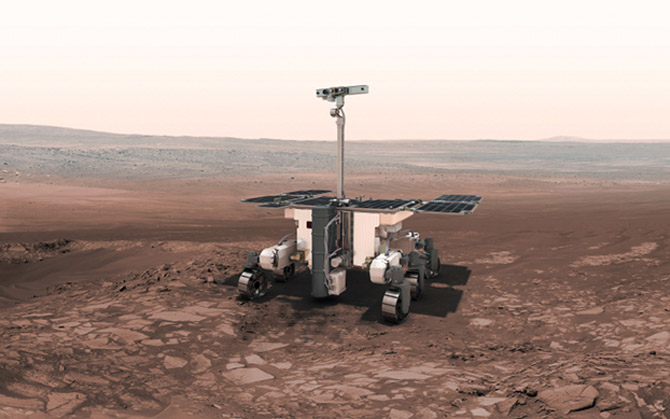
20 September 2022
ExoMars is a joint endeavour between the European Space Agency and Russia's Roscomos agency, and consists of the 2016 Trace Gas Orbiter, and the 2022 Rosalind Franklin Rover. MSSL is leading the PanCam team to provide the rover's scientific ‘eyes’. The Rosalind Franklin Rover is scheduled to launch in September 2022 and arrive at Mars in June 2023. It will drill up to 2m below the harsh Martian surface to search for signs of past, or even present, life.
The Martian environment presents the main technological challenges facing PanCam. Because the instrument is mounted on the rover mast, it is exposed to the fine dust which settles from the atmosphere and is exposed to a difficult thermal environment. Temperatures may fall as low as -120C, depending on latitude and season, and there is, like on Earth, constant diurnal cycling during the 24 hour 37 minute ‘sol’, with warmer temperatures during the day and colder temperatures at night. Even near the equator, at the rover’s Oxia Planum landing site, the range is quite extreme: perhaps as "warm" as 0-10 °C during the day, but falling to -90 to -100 °C at night. The PanCam team need to ensure that electronics and mechanical parts maintain reliable operation throughout the 218 sol mission.
Like the rest of the rover, PanCam has planetary protection challenges, for example ensuring that we do not contaminate the Martian surface, not only because we want to be good planetary neighbours, but also so we do not affect the results of the sensitive biological and chemical analyses to be performed on-board.
- ExoMars 2022 Science Objectives:
The overall goals of the ExoMars 2020 rover are to search for signs of past and present life on Mars, and to characterise the water/geochemical environment as a function of depth in the shallow subsurface. The key new aspect of the mission as a whole is the retrieval and analysis of samples from up to 2m under the oxidised surface of Mars. The strategy of the mission is:
1. To land at, or to be able to reach, a location possessing high exobiological interest for past or present life signatures, i.e., the Rover must have access to the appropriate geological environment.2. To collect scientific samples from different sites, using a rover carrying a drill capable of reaching well into the subsurface and into surface rocky outcrops.
3. At each site, to conduct an integral set of measurements at multiple scales: beginning with a panoramic assessment of the geological environment, progressing to smaller-scale investigations on surface outcrops, and culminating with the collection of well-selected subsurface (or surface) samples to be studied in the Rover's analytical laboratory.
- PanCam Science Objectives
The PanCam instrument plays a key role in the mission by contributing to item 3 above. The main objectives of the ExoMars rover PanCam instrument are to:
1. Provide context information for the rover and its environment, including digital elevation models and their proper visualisation.
2. Geologically investigate and map the rover sites including drilling locations.
3. Study the properties of the atmosphere and variable phenomena, including water and dust content of the atmosphere.
4. Locate the landing site and the rover position with respect to local references, by comparison and data fusion with data from orbiters
5. Support rover track planning
6. Image the acquired sample
The PanCam science team has developed a detailed science traceability matrix which links the high level goals to instrument performance.
PanCam plays a key role as part of the lander payload in several ways associated with wide angle and high resolution imaging, as mentioned above. We now consider the hardware implementation and, in broad terms, how the instrument addresses the objectives.
PanCam sets the geological and morphological context for the rest of the payload. Geological and red/green/blue filters provide a powerful camera system for planetary science. A pair of Wide Angle Cameras (WACs) and a close-up High Resolution Camera (HRC) provide complementary imaging at different scales. PanCam can view the lander top surface and verify mechanism deployments and potentially landing pad interaction with the regolith. In the current ExoMars design, PanCam is the only instrument which can remotely sense the geological context of the landing site, provide detailed 3D terrain models and measure the surface Bidirectional Reflectance Distribution Function (BRDF).
- PanCam Design
The PanCam design for Mars includes the following major items (see Coates et al., Astrobiology, 2017):
(a) Wide Angle Camera (WAC) pair, for multi-spectral stereoscopic panoramic imaging, using a miniaturised filter wheel. The WAC camera units themselves are provided byThales Alenia Space, Switzerland, and the filter wheels and drives are produced by Mullard Space Science Laboratory, University College London (MSSL-UCL).
(b) High Resolution Camera (HRC) for high resolution colour images. The HRC hardware is produced by OHB, Munich and DLR Institute for Planetary Research, Berlin, Germany.
(c) Pancam Interface Unit (PIU) and DC-DC converter to provide a single electronic interface. The PIU and DC-DC converter are provided by MSSL-UCL.
(d) PanCam Optical Bench (OB) to house PanCam and provide planetary and dust protection. The OB is provided by MSSL-UCL.
The PanCam mechanical design is illustrated below. The optical bench is located on a rover-supplied pan-tilt mechanism at the top of the rover mast, at a height of ~2m above the Martian surface.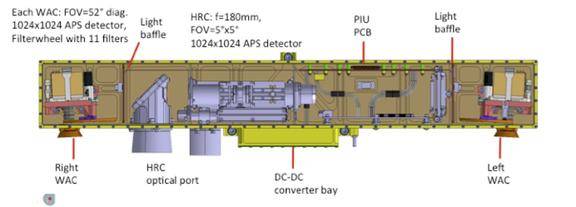
PanCam layout (Credit: MSSL)
The main characteristics of the WACs and HRC are shown in Table 1.Table 1 - PanCam performance WACs (x2)
HRC
FoV (°)
38.3 (edge)
4.88
Pixels
1024x1024
1024x1024
Filter type
Multispectral
RGB
Filter type
Filter wheel
Bayer
Filter number
11 per ‘eye’
1
IFOV (µrad/pixel)
653
83
Pixel scale (2m)
1.31mm
0.17 mm
Focus
Fixed
(1.0m-∞)
Mechanical autofocus (0.98m-∞)
Each of the WACs includes 11 filters comprising R,G and B colour bands, a geological filter set (optimised for use on Mars, especially water-rich mineral identification) and atmospheric filters to analyse the water and dust content in the Mars atmosphere. The filter wheel and WAC camera system is illustrated below.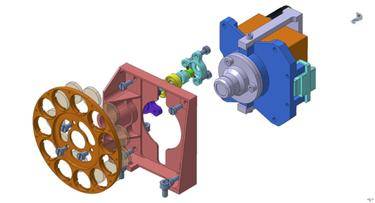
Mechanical configuration of WAC filter wheel and cameras (C.Theobald/MDO, MSSL-UCL)
The HRC includes a Bayer filter to provide colour information. The optical path is housed within the optical bench structure and comprises a baffle and mirror arrangement, a focus mechanism and a detector with associated readout electronics, shown below.
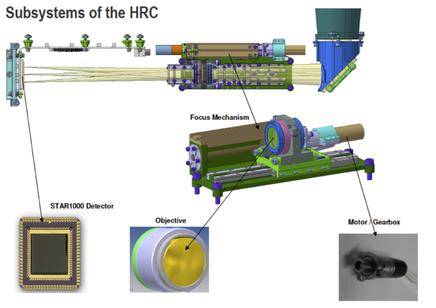
HRC subsystems : a) exploded view and b) accommodated into an Optical Bench prototype (DLR/KT/MSSL)
The PIU is the main interface between the ExoMars rover and the PanCam subsystems, and uses an FPGA implementation. The final system component is the Optical Bench, which provides a planetary protection barrier to the external environment (including HEPA filters), as well as mechanical positioning of the PanCam components. A view of the Proto-Flight-Model is shown in below.
Proto-flight mode of PanCam (MSSL)In addition to the major four PanCam optical bench mounted components outlined above, three additional hardware components known as the ‘Small items’ are part of the PanCam design to improve the scientific return and provide useful engineering data, namely the PanCam calibration target (PCT), rover inspection mirror (RIM) and fiducial markers (FidMs), both provided by Aberystwyth University.
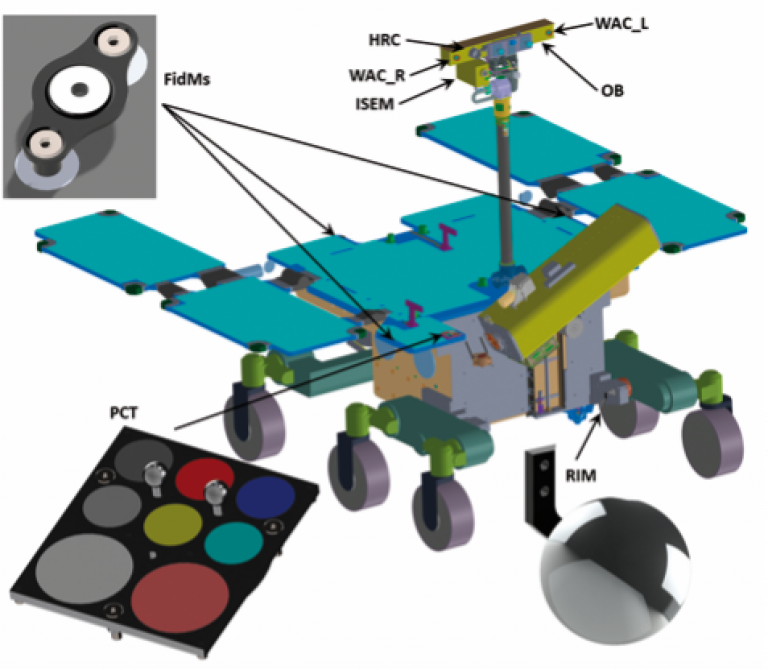
PanCam arrangement on the rover (schematic). The Optical bench is at the top of the mast, the PCT is at the front of the rover, the FidMs on the top deck and the RIM near the front bogey of the rover.
The PanCam calibration target (PCT) is implemented using coloured glass elements similar to ‘stained glass’ with a shadow post for relief. The calibration target is located on the rover deck. The design accommodates the ISEM calibration target.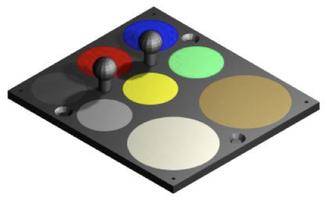
PanCam and ISEM Calibration Target (PCT) design – Aberystwyth University
Radiometric and geometric calibration is overseen by MSSL with involvement from Aberystwyth, Joanneum Research and DLR.
In addition to the PanCam hardware components mentioned above, the ExoMars PanCam team includes a 3D vision team which provides key software and calibration support for the PanCam team.
- Field Trials
A number of ExoMars-related field trials and tests have been performed in the last few years, including participation in recent Arctic Mars Analogue Svalbard Expeditions (AMASE) 2008-11, Iceland (2014-5), MURFI (2016, Utah), ExoFit (2019, Atacama). For these tests, a representative PanCam simulator was used, provided by Aberystwyth University. This simulator includes representative (though not the final) filter wavelengths from which spectral information may be used to study mineralogy. These campaigns have been used, in combination with teams from other ExoMars instruments, to develop working procedures representative of a mission to Mars, as well as to test instrument performance, develop calibration techniques and pursue scientific investigations of particular areas. These included e.g., the Bockfjord Volcanic Complex (BVC), and the Nordaustlandet/Palander Icecap.
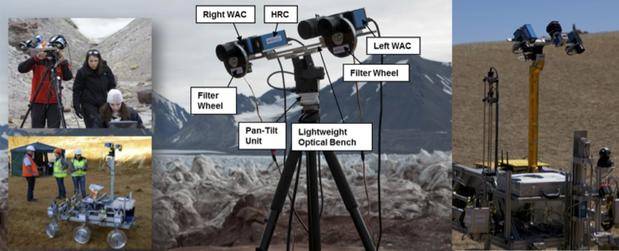
The AUPE PanCam simulator at tests in a Hertfordshire, UK quarry and at the AMASE campaign, Svalbard
Other PanCam ground tests have included ‘blind’ geological identifications performed in the AU Mars analogue facility, tests in a quarry in Hertfordshire with the Astrium UK ‘Bridget’ prototype rover, tests as part of the SAFER campaign, tests in Iceland in 2013 and 2015, tests in Boulby mine and tests with the Raman team in Staffordshire, UK (2015).- PanCam Instrument Team
Name
Function
Location
Andrew Coates
PanCam PI (TC)
UCL-MSSL (UK)
Mary Carter
PanCam Project Manager
UCL-MSSL (UK)
Nicole Schmitz
PanCam Co-PI, HRC lead scientist
DLR-PF (D)
Jean-Luc Josset
PanCam Co-PI, WAC
Space Exploration Inst. (CH)
Matt Balme
PanCam deputy PI, science deputy
OU (UK)
Ernst Hauber
Science deputy
DLR-PF (D)
Gerhard Paar
Lead Co-I, 3D Vision
Joanneum Research (A)
Matt Gunn
Lead Co-I, instrument calibration scientist, radiometric correction software, AU Coordinator
Aberystwyth University (UK)
Craig Leff
PanCam Operations Lead, Data Archive manager
UCL-MSSL (UK)
Tom Hunt
PanCam System Engineer
UCL-MSSL (UK)
Barry Whiteside
PanCam System Engineer
UCL-MSSL (UK)
Graham Willis
PanCam PA Manager
UCL-MSSL (UK)
Alex Rousseau
PanCam PP&CC Engineer
UCL-MSSL (UK)
Guy Baister
WAC Project Manager
TAS-CH (CH)
Frank Trauthan
DLR HRC Operations
DLR-PF (D)
Carsten Henselowsky
PM for DLR contract with OHB
DLR-Bonn (D)
Elena Gubbini
OHB HRC Project Manager
OHB (D)
Harald Steininger
HRC PP&CC Engineer
OHB (D)
Sue Home
LFA (UKSA) representative

- PanCam Science Team
The Instrument Science Team includes Andrew Coates (MSSL), Nicole Schmitz (DLR), Jean-Luc Josset (SEI), Matt Balme (OU), Ernst Hauber (DLR), Matt Gunn (AU) and Gerhard Paar (JR) from the instrument team above; plus the following team members:
Team Members
Institution
Solmaz Adeli
DLR (D)
Francesca Altieri
IAPS, INAF (I)
Elyse Allender
U. St Andrews (UK)
Matt Balme
Open University (UK)
Steve Banham
Imperial College (UK)
Rob Barnes
Imperial College (UK)
Jean Pierre Bibring
IAS, Orsay (F)
Eleni Bohacek
UCL (UK)
Tomaso Bontognali
Space Exploration Inst. (CH)
John Bridges
SRC, U. Leicester (UK)
Valerie Ciarletti
LATMOS (F)
Claire Cousins
U. St Andrews (UK)
Ian Crawford
Birkbeck U. London (UK)
James Darling
U. Portsmouth (UK)
Joel Davis
Natural History Museum (UK)
Jean-Pierre de Vera
DLR (D)
Ramy el-Maary
Khalifa U (UAE)
Nadezhda Evdokimova
IKI RAN (Ru)
Alberto Fairén
INTA (E)
Elena Favaro
OU (UK)
Peter Fawdon
OU (UK)
Anna Fedorova
IKI RAN (Ru)
Bernard Foing
ILEWG EuroMoonMars, Leiden/VU Amsterdam/CNRS (NL)
François Forget
CNRS (F)
Yang Gao
U. of Surrey (UK)
Stephan van Gasselt
FU-Berlin (D)
Matt Golombek
JPL (USA)
John Grant
Smithsonian Institution (USA)
Peter Grindrod
Natural History Museum (UK)
Sanjeev Gupta
Imperial College (UK)
Klaus Gwinner
DLR-PF (D)
Harald Hiesinger
U. Münster (D)
Beda Anton Hofmann
Naturhistorisches Museum, Bern (CH)
Pat Irwin
Oxford (UK)
Ralf Jaumann
FUB (D)
Geraint Jones
MSSL/UCL (UK)
Marie Josset
Space Exploration Institute (CH)
Christian Köberl
University of Vienna (A)
Ruslan Kuzmin
GEOKhI RAN (Ru)
Ariel Ladegaard
AU (UK)
Laetitia Le Deit
LPG Nantes, CNRS (F)
Mark Leese
Open University (UK)
Greg Michael
FUB (D)
Helen Miles
AU (UK)
Sara Motaghian
Natural History Museum (UK)
Stefano Mottola
DLR/IPF, Berlin (D)
Jürgen Oberst
DLR/IPF, Berlin (D)
Gordon Osinski
Univ. of Western Ontario (Ca)
Tim Parker
JPL (USA)
Manish Patel
Open University (UK)
Priya Patel
UCL-MSSL, UK
Dirk Plettemeier
Technische Universität Dresden (D)
Louisa Preston
Birkbeck U. London (UK)
Frank Preusker
DLR/IPF, Berlin (D)
Cathy Quantin-Nataf
U. Lyon (F)
Catherine Regan
UCL-MSSL, UK
Peter Rueffer
TUB (D)
Maria Cristina de Sanctis
IASF, INAF (I)
Frank Scholten
DLR (D)
Christian Schroeder
U. Stirling (UK)
Caroline Smith
Natural History Museum (UK)
Roger Stabbins
MSSL/UCL (UK)
Katrin Stephan
DLR (D)
Mitko Tanevski
Space Exploration Institute (CH)
Nick Thomas
Physikalisches Institut Bern (CH)
Roland Trautner
ESA/ESTEC (NL)
Frances Westall
CNRS (F)
Lyle Whyte
Dept. of Natural Resource Sciences, McGill University (Ca)
Rebecca Williams
PSI (USA)
Colin Wilson
Oxford (UK)
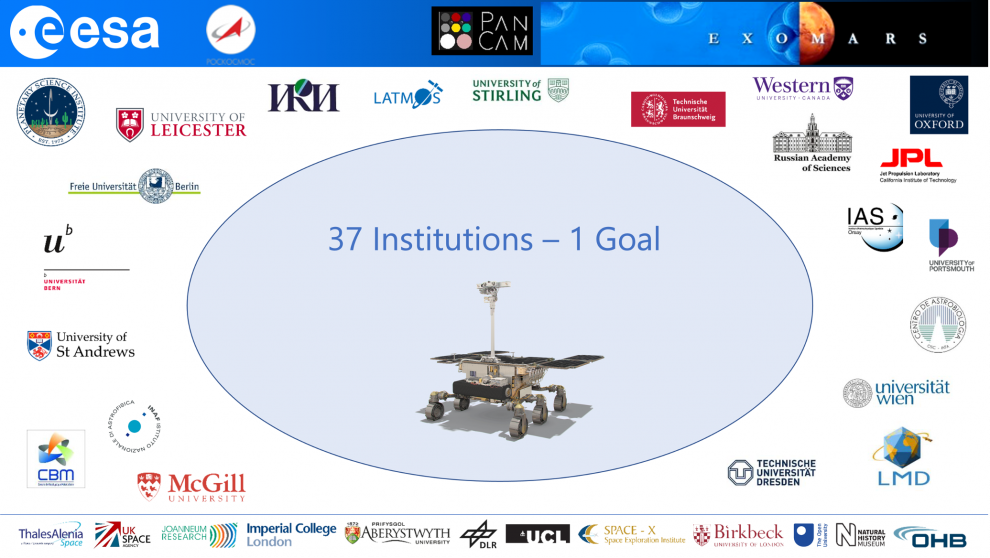
 Close
Close

